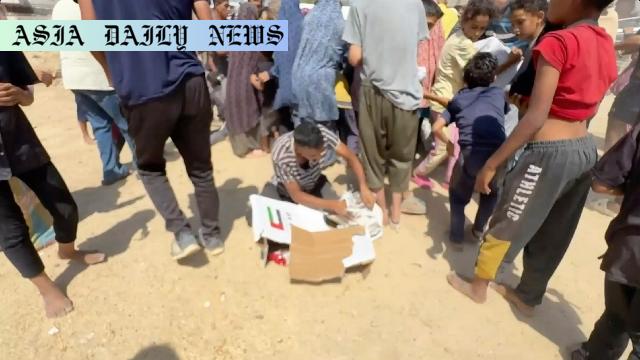Gaza Aid Crisis: Aid efforts are hindered by distribution issues and escalating food prices leaving residents in dire conditions.
Limited aid reaching Gaza despite daily deliveries.
Soaring food prices leave many residents struggling.
Vendors reselling aid adds to distribution challenges.
Airdrops create chaos and lack dignity in delivery.
Residents demand checkpoints reopening for proper aid access.

Challenges in Delivering Aid to Gaza Residents
The ongoing efforts to deliver humanitarian aid to Gaza since the limited ceasefire on July 27 have highlighted critical inefficiencies in distribution mechanisms. Despite over 200 truckloads of supplies being sent daily, many Gaza residents remain without sufficient access to the essentials they desperately need. NHK’s recent investigation underscores the issue, revealing that supplies such as food, medicine, and other necessities reach only a segment of the population. This shortfall has been further exacerbated by the reselling of vital aid by street vendors at exorbitant prices, making it inaccessible to many.
The Struggles of Vendors and Escalating Food Costs
Street vendors in Gaza, striving to support their families, often procure and resell aid supplies intended for the needy. One such vendor explained that reselling beans and rice, originally distributed by the UN, offered his family a means of survival amid the crisis. However, these markups come at a cost, as they render vital supplies unaffordable for many. For instance, the price of cooking oil has skyrocketed from $2.7 to $18 per liter since the onset of the conflict. This inflation has created devastating conditions where families can purchase little beyond basic items like flour, compounding the suffering of already impoverished households.
Airdrops: The Dignity and Accessibility Debate
To supplement deliveries via trucks, countries like Jordan and the UAE have been using transport planes for daily airdrops of crucial supplies to Gaza. Unfortunately, this method has sparked intense disagreements. While airdrops can bypass some logistical barriers, they also lead to chaotic scuffles on the ground, oftentimes leaving weaker or vulnerable individuals without any aid. A resident likened the method to a humiliating spectacle, emphasizing the indignity of fighting over parachute-tied supplies. Reopening entry checkpoints into Gaza has been called for as a more effective and dignified solution to distributing aid evenly and respectfully.
Starvation and the Dire Humanitarian Crisis
The voices of Gaza’s residents paint a stark picture of the humanitarian crisis unfolding within the enclave. One woman explained that the inability to afford basic necessities like fruit and cooking oil mirrored waiting for ‘her turn to starve.’ Emotive accounts like this illustrate the extensive hunger and despair sweeping through Gaza, with malnutrition reportedly at some of its highest levels in recent years. Without changes to aid distribution systems and economic factors like skyrocketing food costs, these conditions are likely to worsen further, leading to irreversible consequences for countless families.
The Path Towards Sustainable Solutions
Immediate intervention aimed at improving the distribution of aid supplies, regulating food prices, and restoring dignity to the aid process is urgently needed. Establishing secure and monitored distribution networks, reopening vital checkpoints, and ensuring transparency in handling aid could bridge the current divide between delivery and consumption. On a broader scale, resolving political and diplomatic disputes is essential to fostering lasting peace and stability in Gaza, enabling economic recovery and self-sufficiency for its beleaguered residents.
Commentary
Unpacking the Complexities of Gaza’s Aid Crisis
The recent findings on the inadequacies of aid delivery in Gaza call for urgent attention and deeper introspection. Despite good intentions behind humanitarian efforts, the ground reality highlights the failure of current systems in ensuring equitable distribution amidst a worsening crisis. The glaring irony of aid supplies ending up in vendor stalls rather than the hands of the most vulnerable showcases a significant lapse in monitoring and logistical coordination. This not only undermines the purpose of humanitarian efforts but also exacerbates mistrust and resentment among the residents of Gaza.
The Human Cost of Economic Disparities
The economic impact of the aid crisis is equally alarming. Price inflation for everyday items like cooking oil and basic grains has spiraled out of control, leaving many families unable to afford even the bare minimum. This scenario underscores a profound economic disparity that perpetuates cycles of poverty and desperation in Gaza. It is disheartening to witness a situation where communities must resort to reselling aid supplies as their sole means of sustenance. While these vendors should not bear the full brunt of criticism, their actions highlight the unintended consequences of flawed aid frameworks.
Reimagining Humanitarian Aid with Dignity
Perhaps the most distressing aspect of the aid crisis is the method of airdropping supplies, which residents describe as humiliating. While parachute-delivered aid may be a quick solution, it fails to respect the dignity of those in need. Establishing secure distribution channels through reopened checkpoints and coordinated on-ground efforts would not only be more efficient but also restore a sense of humanity to this process. The international community must rethink its approach, balancing urgency with empathy, and ensuring that aid is not just provided but is received with dignity and equality.


